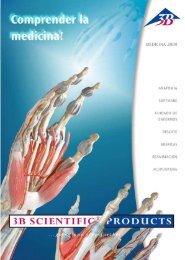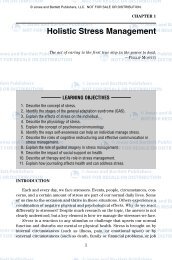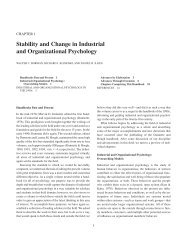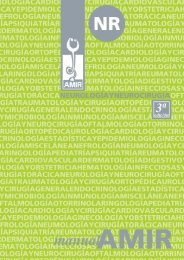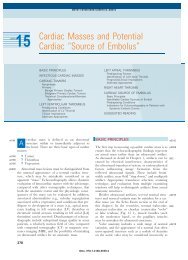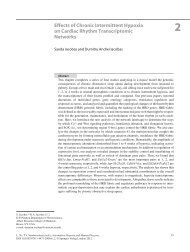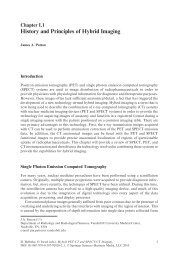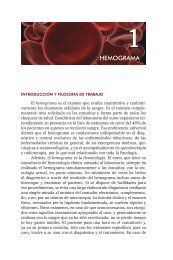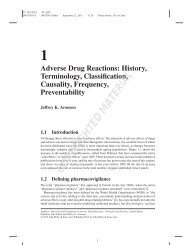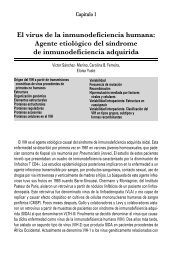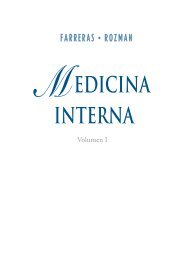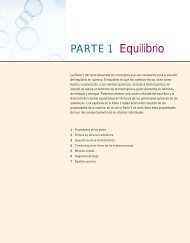Download Sample pages 1 (pdf, 195 kB) - Springer
Download Sample pages 1 (pdf, 195 kB) - Springer
Download Sample pages 1 (pdf, 195 kB) - Springer
You also want an ePaper? Increase the reach of your titles
YUMPU automatically turns print PDFs into web optimized ePapers that Google loves.
28 J. Hallenbeck<br />
of our pain and provide relief from it. 3 Power differentials generally stay in the background in clinical<br />
care unless major disputes arise. In such cases, jostling for power positions may become a subtext to<br />
clinical encounters. Clinicians may stress their authority, through clinical role, competency/expertise,<br />
and law, to be the judges of who gets what therapy. Patients who disagree with clinical decisions<br />
may stress their “patient rights” and general autonomy. They may claim discrimination and stigma.<br />
Or they may argue from the position that their pain and associated suffering are ultimately unknowable<br />
by others. The subtext often seems to read, “It is my pain. You cannot possibly know what this<br />
is like. Why are you in charge of my suffering?” It is true. While pain may or may not be affi rmed<br />
or even legitimized, it cannot be denied. As clinicians we may have the power to deny desired medications<br />
or therapies, but we can never be completely sure in our opinions as to whether or not pain<br />
is actually present.<br />
Paradoxically, given this, patients do have a certain power. Precisely because objective markers for<br />
pain are lacking, it is impossible to prove that someone is not in pain. Kleinman has noted that complaints<br />
of pain may be one of a limited set of sanctioned means of protest within ascribed sick roles<br />
in certain social and political contexts. For example in China, as Kleniman explores, complaints of<br />
pain may represent a relatively acceptable form of protest against totalitarian aspects of society<br />
(Kleinman 1994 ) . As such, complaints of pain may in part refl ect an effort of disempowered individuals<br />
to be socially acknowledged and to gain some control over their lives. Again, here we must stress<br />
that in terms of communication the issue is not whether such complaints are or are not “real.”<br />
Independent of any such reality complex dynamics of power exist for both clinicians and patients. 4<br />
There is nothing inherently wrong with the fact that power is an issue in encounters regarding<br />
pain. However, issues of power may escalate to frank battles at the level of discourse and practice,<br />
wounding patients and clinicians alike, if the subtext is not acknowledged and addressed in some<br />
meaningful way either through the subtext or by raising the subtext to the text. As discussed further<br />
below, when a subtext, power, or any other is addressed through (or within) the subtext, this means<br />
that the clinician, who is aware of such a subtext, modifi es what he or she says or does in a manner<br />
that addresses the concern of the subtext, but without drawing explicit attention to that subtext. For<br />
example, in addressing a power subtext through the subtext the clinician might state his or her understanding<br />
of expectations and responsibilities for both his or herself and the patient. “Raising the<br />
subtext to the text” might be done by calling attention to a power struggle underway and explicitly<br />
addressing power concerns. For example, a physician might state, “We are struggling with who gets<br />
to decide what medicine is best for you. I understand that only you can really appreciate how much<br />
pain you are in. However, the state says that when I write a prescription, it is on my license. So I have<br />
a professional obligation to meet certain standards of care in doing so. I don’t blame you for being<br />
frustrated with this, but, yes, I am in charge of determining how much and what medicine to give<br />
you. I will do my best to listen to you and weigh your concerns in making a decision.”<br />
While the above could be expanded upon and arguably other common relational themes could also<br />
be added, hopefully the reader gets the point. While such subtexts often play a signifi cant role in high<br />
context clinical encounters, they usually remain in the subtext, and are therefore not acknowledged.<br />
3 As a palliative care physician, who teaches pain management to physicians-in-training, I am acutely aware that<br />
should I need opioids for some pain, I am completely at the mercy of such physicians and their colleagues for relief.<br />
While I can, if need be, prescribe my own blood pressure pills and many other medications (wisely or unwisely),<br />
I cannot prescribe for myself or my family opioids or other controlled substances. I am not suggesting that this is<br />
wrong, but given the well-documented lack of general competency in primary pain management, it is worrisome and<br />
a strong motivator for me as a teacher.<br />
4 Scarry presents a detailed discussion of legitimacy and power in relation to torture. Her thesis is that torture is not so<br />
much about information gathering as it is an attempt by a regime whose legitimacy is threatened to bolster legitimacy<br />
through the “unmaking” or de-legitimatizing the world of the dissident through a display of power and the induction<br />
of pain. While such a discussion is far from the fi eld of clinical care, it graphically highlights the importance of legitimacy<br />
and power in any discussion about pain (Scarry 1985 ) .





